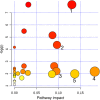Metabolomic signatures and microbial community profiling of depressive rat model induced by adrenocorticotrophic hormone
- PMID: 31307473
- PMCID: PMC6631535
- DOI: 10.1186/s12967-019-1970-8
Metabolomic signatures and microbial community profiling of depressive rat model induced by adrenocorticotrophic hormone
Abstract
Background: Adrenocorticotrophic hormone (ACTH)-treatment rat model has been utilized as a widely accepted model of treatment-resistant depression. Metabolomic signatures represent the pathophysiological phenotype of diseases. Recent studies in gut microbiota and metabolomics analysis revealed the dramatic role of microbiome in psychoneurological system diseases, but still, the mechanisms underlying gut microbiome-host interaction remain unclear.
Methods: Male Wistar rats were s.c. injection of ACTH fragment 1-24 for 14 days to induce treatment-resistant depression. Depression-related behavioral tests, analysis of serum monoamine neurotransmitters and hypothalamic-pituitary-adrenal (HPA) axis-related hormones were determined for assessment of ACTH-induced depression rat model. A gas chromatography-time-of-flight mass spectrometer based urinary metabolomic signatures integrated 16S rRNA sequence analysis based gut microbial profiling was performed, as well as Spearman's correlation coefficient analysis was used to manifest the covariation between the differential urinary metabolites and gut microbiota of genus level.
Results: Chronic injection of ACTH-induced depression-like phenotype (increased immobility time in forced swimming test and tail suspension test) was accompanied by peripheral serotonin down-regulation and HPA axis overactivation (ACTH and corticosterone up-regulation). Urinary metabolomics analysis indicated that pyruvic acid, L-threonine, mannitol, D-gluconic acid, 4-hydroxybenzoic acid, D-arabitol, myo-inositol and ascorbic acid levels were reduced in ACTH-treated rats' urine, while hippurate level was elevated. In addition, microbial community profiling revealed bacterial enrichment (e.g. Ruminococcus, Klebsiella) and reduction (e.g. Akkermansia, Lactobacillus) in the ACTH-induced depression rat model. Correlation analysis showed that Akkermansia and Lactobacillus were closely relevant to metabolites myo-inositol and hippurate, which were included in host inositol phosphate metabolism, and phenylalanine, tyrosine and tryptophan biosynthesis.
Conclusions: Depression rat model induced by ACTH is associated with disturbance of pyruvate metabolism, ascorbate and aldarate metabolism, inositol phosphate metabolism, glycine, serine and threonine metabolism, and glycolysis or gluconeogenesis, as well as changes in microbial community structure. Gut microbiota may participate in the mediation of systemic metabolomic changes in ACTH-induced depression model. Therefore, integrated metabolomic signatures and gut microbial community profiling would provide a basis for further studies on the pathogenesis of depression.
Keywords: Depression; Gut microbiota; HPA axis; Metabolomics.
Conflict of interest statement
The authors declare that they have no competing interests.
Figures





Similar articles
-
Chronic paradoxical sleep deprivation-induced depression-like behavior, energy metabolism and microbial changes in rats.Life Sci. 2019 May 15;225:88-97. doi: 10.1016/j.lfs.2019.04.006. Epub 2019 Apr 4. Life Sci. 2019. PMID: 30953642
-
Variations in gut microbiota and fecal metabolic phenotype associated with depression by 16S rRNA gene sequencing and LC/MS-based metabolomics.J Pharm Biomed Anal. 2017 May 10;138:231-239. doi: 10.1016/j.jpba.2017.02.008. Epub 2017 Feb 10. J Pharm Biomed Anal. 2017. PMID: 28219800
-
An Integrated Fecal Microbiome and Metabolomics in T2DM Rats Reveal Antidiabetes Effects from Host-Microbial Metabolic Axis of EtOAc Extract from Sophora flavescens.Oxid Med Cell Longev. 2020 May 27;2020:1805418. doi: 10.1155/2020/1805418. eCollection 2020. Oxid Med Cell Longev. 2020. PMID: 32566075 Free PMC article.
-
Gut metabolome meets microbiome: A methodological perspective to understand the relationship between host and microbe.Methods. 2018 Oct 1;149:3-12. doi: 10.1016/j.ymeth.2018.04.029. Epub 2018 Apr 30. Methods. 2018. PMID: 29715508 Review.
-
Metabolomics approaches for characterizing metabolic interactions between host and its commensal microbes.Electrophoresis. 2013 Oct;34(19):2787-98. doi: 10.1002/elps.201300017. Epub 2013 Aug 16. Electrophoresis. 2013. PMID: 23775228 Review.
Cited by
-
Alzheimer's disease and depression in the elderly: A trajectory linking gut microbiota and serotonin signaling.Front Psychiatry. 2022 Nov 30;13:1010169. doi: 10.3389/fpsyt.2022.1010169. eCollection 2022. Front Psychiatry. 2022. PMID: 36532180 Free PMC article. Review.
-
Vitamin-mediated interaction between the gut microbiome and mitochondria in depression: A systematic review-based integrated perspective.Brain Behav Immun Health. 2024 May 10;38:100790. doi: 10.1016/j.bbih.2024.100790. eCollection 2024 Jul. Brain Behav Immun Health. 2024. PMID: 38974216 Free PMC article. Review.
-
Whole genome sequence analysis of two subspecies of Companilactobacillus Futsaii and experimental verification of drug resistance and effect on the exploratory behavior of mice based on unique gene.PLoS One. 2022 Sep 9;17(9):e0274244. doi: 10.1371/journal.pone.0274244. eCollection 2022. PLoS One. 2022. PMID: 36084068 Free PMC article.
-
Serum Metabolic Profiling Reveals the Antidepressive Effects of the Total Iridoids of Valeriana jatamansi Jones on Chronic Unpredictable Mild Stress Mice.Front Pharmacol. 2020 Mar 20;11:338. doi: 10.3389/fphar.2020.00338. eCollection 2020. Front Pharmacol. 2020. PMID: 32265710 Free PMC article.
-
Integrated metagenomic and metabolomic analyses of the effects of total flavonoids of Rhizoma Drynariae on reducing ovariectomized-induced osteoporosis by regulating gut microbiota and related metabolites.PLoS One. 2025 Feb 14;20(2):e0317832. doi: 10.1371/journal.pone.0317832. eCollection 2025. PLoS One. 2025. PMID: 39951448 Free PMC article.
References
-
- World Health Organization. Depression and other common mental disorders. 2017; WHO/MSD/MER/2017.2.
Publication types
MeSH terms
Substances
LinkOut - more resources
Full Text Sources
Medical
Molecular Biology Databases

